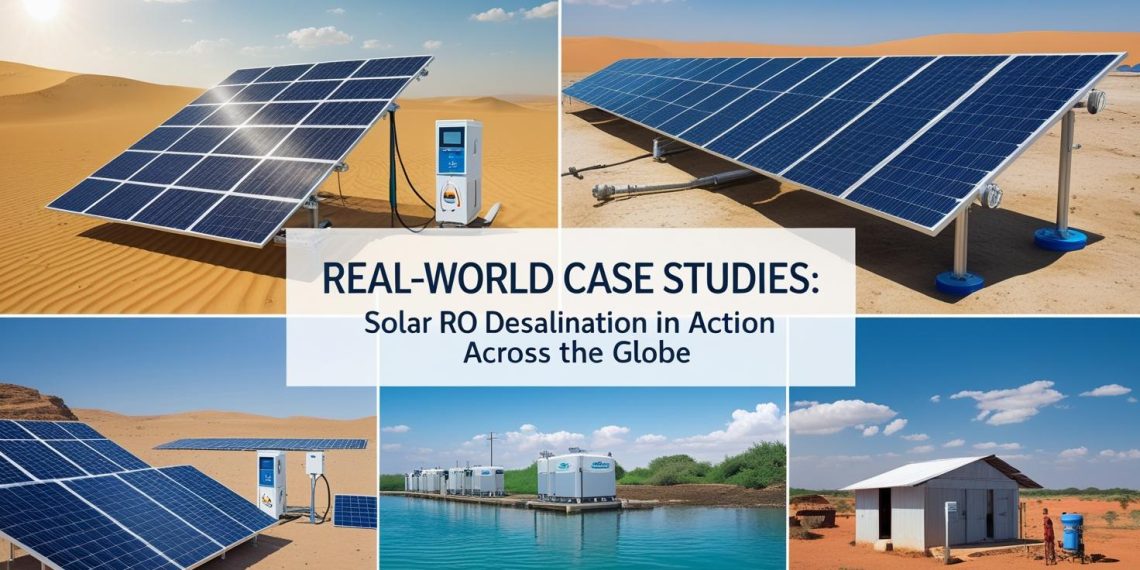While the idea of solar-powered water purification might sound futuristic to some, solar RO desalination machines are already making a significant impact in the real world. From rural villages in Africa to emergency response missions in coastal regions, these systems are helping thousands access safe, drinkable water — completely off-grid.
In this blog, we’ll explore five global case studies where solar-powered reverse osmosis (RO) systems have not only met water demands but transformed communities and operations. We’ll also explain why these solutions matter in the broader mission of sustainability, climate resilience, and water security.
1. Coastal Village in Kenya: Clean Water Without Infrastructure
Challenge:
A small fishing village along Kenya’s coastline faced chronic water scarcity. Residents relied on brackish groundwater that was unsafe to drink. Due to the remoteness of the area, there was no grid electricity available.
Solution:
A 5,000 GPD solar-powered reverse osmosis system, based on AMPAC USA technology, was installed by a global NGO.
Outcome:
The system now purifies brackish water into potable water for more than 800 residents daily. Waterborne illnesses have decreased significantly. Women and children, once burdened by fetching water from miles away, now have access right in their community.
Key Benefit:
The solar-powered, low-maintenance design allows 24/7 operation in a region with limited resources and infrastructure.
Read: How Solar-Powered Desalination Machines Work: A Complete Guide for Sustainable Water Purification
2. Disaster Relief in the Philippines: Emergency Deployment
Challenge:
In the wake of Typhoon Haiyan, thousands were left without clean water. Contaminated floodwater and damaged infrastructure made it difficult to distribute bottled water quickly.
Solution:
Mobile solar RO desalination units were deployed as part of an emergency response program in coordination with disaster relief agencies.
Outcome:
Within 48 hours, the mobile systems were delivering up to 2,500 GPD of clean water per unit. These units served as lifelines for temporary medical camps and refugee shelters.
Key Benefit:
Rapid deployment, no reliance on external power or fuel, and ability to serve large numbers during emergencies.
3. Island Resort in the Maldives: Sustainable Tourism
Challenge:
A luxury eco-resort on a private island needed a clean, sustainable water solution. Importing bottled water was logistically complex and environmentally damaging.
Solution:
A fully integrated 10,000 GPD solar desalination system with battery backup and smart monitoring was installed.
Outcome:
Guests now enjoy 100% solar-purified drinking water, aligning with the resort’s eco-friendly branding. Plastic bottle waste was cut by 90%, and operating costs decreased significantly.
Key Benefit:
Promotes sustainability while improving the guest experience and lowering environmental impact.
Read: Top Benefits of Using Solar RO Systems in Remote and Off-Grid Areas
4. Agricultural Farm in Northern Mexico: Brackish Groundwater for Crops
Challenge:
A farm located in an arid zone of Northern Mexico relied on brackish groundwater that was unsuitable for irrigation. Without access to municipal water or power lines, crop yields suffered.
Solution:
A solar-powered brackish RO system with a 7,500 GPD capacity was installed and connected directly to the irrigation network.
Outcome:
The system treats and distributes clean water across 25 acres of farmland, improving soil quality and crop yield by 35%. The use of solar energy also helped the farm achieve carbon neutrality.
Key Benefit:
Self-sufficient irrigation enabled sustainable agriculture in a previously marginal area.
5. Military Field Operations in the Middle East: Off-Grid Water Supply
Challenge:
Military outposts in arid zones needed an on-site source of drinking water that didn’t rely on convoys or long logistical chains.
Solution:
Rugged, containerized solar-powered RO units were provided by AMPAC USA. Built for mobility and extreme environments, they included brine discharge management and UV post-treatment.
Outcome:
Each mobile unit consistently produced over 5,000 GPD of water, supporting hydration, sanitation, and cooking needs.
Key Benefit:
Reduced logistical costs, higher security, and self-sufficient water supply in high-risk zones.
Why These Case Studies Matter
These stories demonstrate that solar desalination isn’t a concept — it’s a proven, effective solution. From improving public health in underdeveloped villages to reducing plastic waste in luxury resorts, solar RO systems offer:
- Clean water where it’s most needed
- Renewable energy utilization
- Reduced dependency on diesel and electricity
- Flexible deployment from remote farms to emergency relief centers
As climate challenges intensify and freshwater scarcity becomes global, solar-powered watermakers will play a vital role in building resilient, decentralized water infrastructure.
Partner with AMPAC USA for Proven Solutions
AMPAC USA is a global leader in high-efficiency solar seawater desalination machines engineered for real-world deployment. From off-grid mobile units to industrial-grade solar RO systems, we offer:
- Custom flow capacities from 2,500 to 15,000 GPD
- Integrated solar arrays
- Pre- and post-treatment systems
- Rugged design for harsh conditions
- 24/7 after-sales support
Explore our Solar Watermaker Systems to learn more.












It’s an amazing post designed for all the web visitors; they will get benefit from it I am sure.